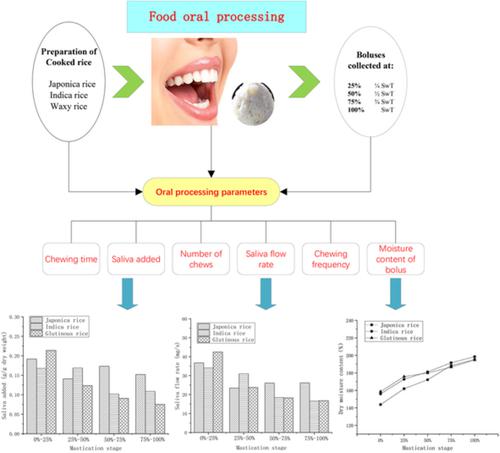当前位置:
X-MOL 学术
›
J. Texture Stud.
›
论文详情
Our official English website, www.x-mol.net, welcomes your
feedback! (Note: you will need to create a separate account there.)
Changes in oral processing parameters of three rice varieties
Journal of Texture Studies ( IF 2.8 ) Pub Date : 2020-05-25 , DOI: 10.1111/jtxs.12526 Dong Xiao Liu 1, 2 , Xin Ren 1, 2 , Sailimuhan Asimi 1, 2 , Jie Peng 1, 2 , Min Zhang 1, 2
Journal of Texture Studies ( IF 2.8 ) Pub Date : 2020-05-25 , DOI: 10.1111/jtxs.12526 Dong Xiao Liu 1, 2 , Xin Ren 1, 2 , Sailimuhan Asimi 1, 2 , Jie Peng 1, 2 , Min Zhang 1, 2
Affiliation

|
Mastication and saliva addition affects the formation of a bolus, directly playing a key role in people's eating enjoyment. However, the specific changes of oral physiological parameters and bolus moisture content in the oral processing of rice have not been studied in detail. Thus, in the present study, salivary flow rate, salivary secretion, chewing frequency, and bolus moisture content during oral processing of three rice varieties (japonica rice, indica rice, and glutinous rice) were fully investigated. The differences among different rice and changes among different oral processing stages (25%, 50%, 75%, and 100%) were analyzed. Results showed that the swallowing time of glutinous rice was significantly lower than that of japonica and indica rice (p <0.05). However, there was no significant difference in the chewing frequency of the three rice varieties throughout the oral processing stages (1.59-1.66 Hz, P > 0.05). During oral processing, the salivary flow rates for the three kinds of rice decreased significantly (P < 0.05), from 37.72 ± 4.32 mg/s (0%-25% stage) to 19.83 ± 5.50 mg/s (75%-100% stage). The dry basis moisture content of the bolus increased significantly (P < 0.05), from 1.53 ± 0.08 (0%) to 1.96 ± 0.02 (100%). In the 75%-100% stage, the amount of saliva secretion for japonica rice was highest, followed by indica rice and glutinous rice (P < 0.05). At the point of swallowing (100% stage), the dry basis moisture content of all three rice-bolus' was consistent (1.94-1.99, P > 0.05) This article is protected by copyright. All rights reserved.
中文翻译:

三个水稻品种口腔加工参数的变化
咀嚼和唾液的添加影响食团的形成,直接影响人们的饮食享受。然而,尚未详细研究大米口服加工过程中口腔生理参数和团粒水分含量的具体变化。因此,在本研究中,对三种水稻品种(粳米、籼米和糯米)在口腔加工过程中的唾液流速、唾液分泌、咀嚼频率和团块水分含量进行了全面调查。分析了不同大米之间的差异和不同口腔加工阶段(25%、50%、75%和100%)之间的变化。结果表明,糯米的吞咽时间明显低于粳米和籼米(p<0.05)。然而,在整个口腔加工阶段,三个水稻品种的咀嚼频率没有显着差异(1.59-1.66 Hz,P > 0.05)。在口服加工过程中,三种大米的唾液流速显着降低(P < 0.05),从 37.72 ± 4.32 mg/s(0%-25% 阶段)降至 19.83 ± 5.50 mg/s(75%-100%)阶段)。丸剂的干基水分含量显着增加 (P < 0.05),从 1.53 ± 0.08 (0%) 到 1.96 ± 0.02 (100%)。在75%-100%阶段,粳稻唾液分泌量最高,其次是籼米和糯米(P < 0.05)。在吞咽时(100% 阶段),三种米丸的干基水分含量一致(1.94-1.99,P > 0.05) 本文受版权保护。版权所有。
更新日期:2020-05-25
中文翻译:

三个水稻品种口腔加工参数的变化
咀嚼和唾液的添加影响食团的形成,直接影响人们的饮食享受。然而,尚未详细研究大米口服加工过程中口腔生理参数和团粒水分含量的具体变化。因此,在本研究中,对三种水稻品种(粳米、籼米和糯米)在口腔加工过程中的唾液流速、唾液分泌、咀嚼频率和团块水分含量进行了全面调查。分析了不同大米之间的差异和不同口腔加工阶段(25%、50%、75%和100%)之间的变化。结果表明,糯米的吞咽时间明显低于粳米和籼米(p<0.05)。然而,在整个口腔加工阶段,三个水稻品种的咀嚼频率没有显着差异(1.59-1.66 Hz,P > 0.05)。在口服加工过程中,三种大米的唾液流速显着降低(P < 0.05),从 37.72 ± 4.32 mg/s(0%-25% 阶段)降至 19.83 ± 5.50 mg/s(75%-100%)阶段)。丸剂的干基水分含量显着增加 (P < 0.05),从 1.53 ± 0.08 (0%) 到 1.96 ± 0.02 (100%)。在75%-100%阶段,粳稻唾液分泌量最高,其次是籼米和糯米(P < 0.05)。在吞咽时(100% 阶段),三种米丸的干基水分含量一致(1.94-1.99,P > 0.05) 本文受版权保护。版权所有。











































 京公网安备 11010802027423号
京公网安备 11010802027423号